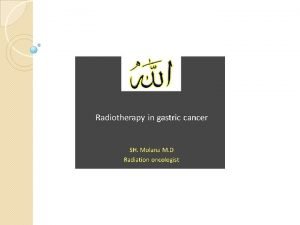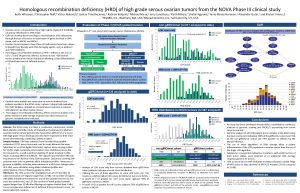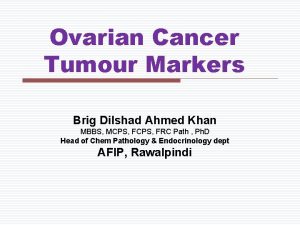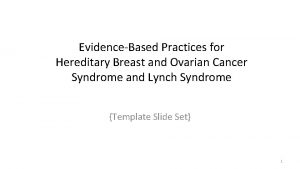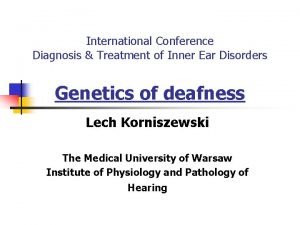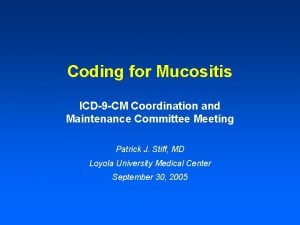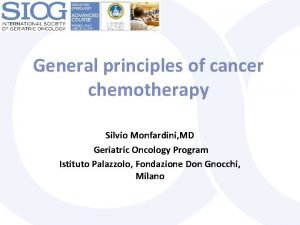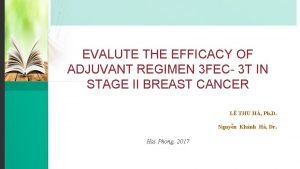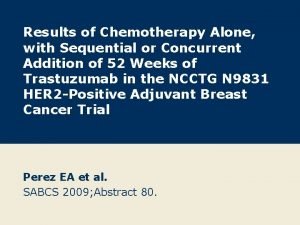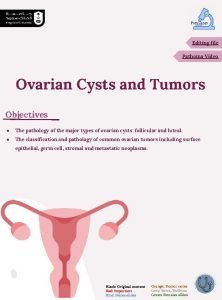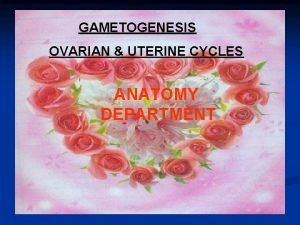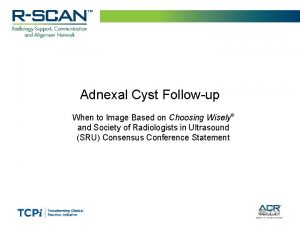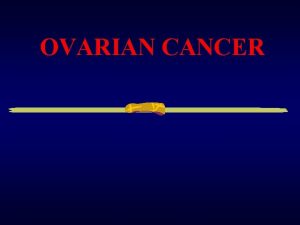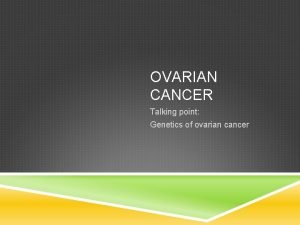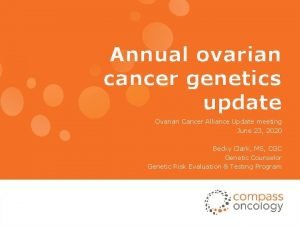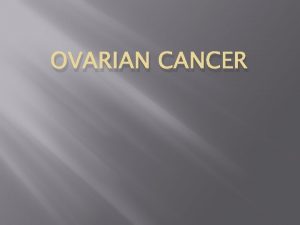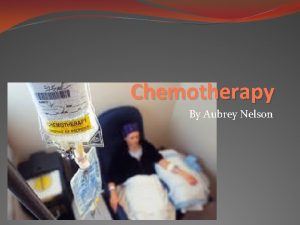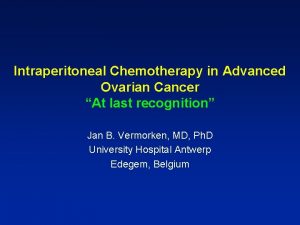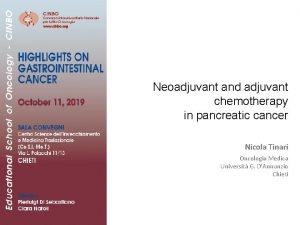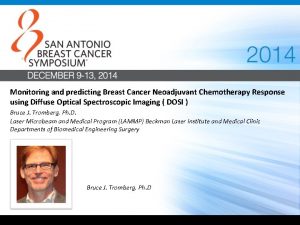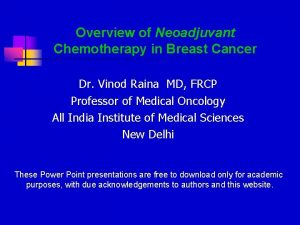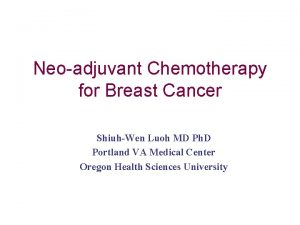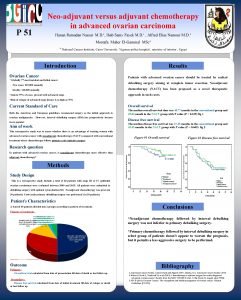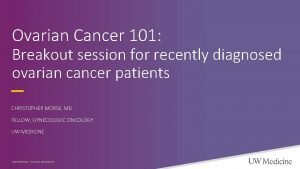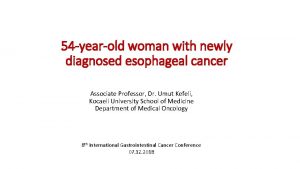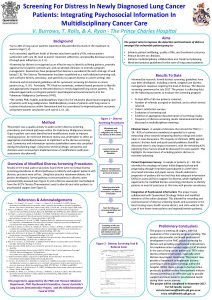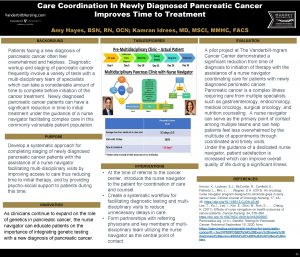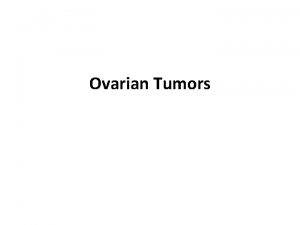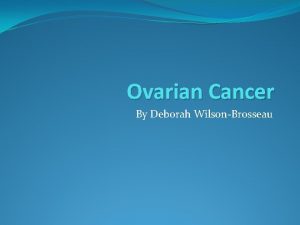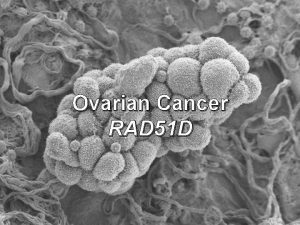Neoadjuvant Chemotherapy for Newly Diagnosed Advanced Ovarian Cancer






















- Slides: 22

Neoadjuvant Chemotherapy for Newly Diagnosed, Advanced Ovarian Cancer: Society of Gynecologic Oncology and American Society of Clinical Oncology Clinical Practice Guideline www. asco. org/NACT-ovarian-guideline ©American Society of Clinical Oncology/Society of Gynecologic Society 2016. All rights reserved.

Introduction The purpose of this guideline is to provide clinicians with information regarding the use of neoadjuvant chemotherapy and interval cytoreduction versus primary cytoreduction and chemotherapy among women with stage IIIC or IV epithelial ovarian cancer. www. asco. org/NACT-ovarian-guideline ©American Society of Clinical Oncology/Society of Gynecologic Oncology 2016. All rights reserved.

SGO/ASCO Guideline Development Methodology The guideline process includes: • a systematic literature review • an expert panel provides critical review and evidence interpretation to inform guideline recommendations • final guideline approval by ASCO Clinical Practice Guidelines, SGO Publications, and the SGO Clinical Practice Committees The full Guideline methodology supplement can be found at: www. asco. org/NACT-ovarian-guideline ©American Society of Clinical Oncology/Society of Gynecologic Oncology 2016. All rights reserved.

Clinical Questions This clinical practice guideline addresses the following clinical questions: (1) What clinical evaluations should be performed in all women with suspected or newly diagnosed stage IIIC or IV epithelial ovarian cancer? (2) Which patient and disease factors should be utilized as criteria for identifying patients who are not suitable for PCS? (3) How do NACT and PCS compare with respect to progression-free survival, overall survival, and perioperative morbidity and mortality in women with newly diagnosed stage IIIC or IV epithelial cancer who are fit for primary cytoreduction and have potentially resectable disease, and how should this information be used to select initial treatment? www. asco. org/NACT-ovarian-guideline ©American Society of Clinical Oncology/Society of Gynecologic Oncology 2016. All rights reserved.

Clinical Questions (4) What additional clinical evaluations should be performed in all women with suspected or newly diagnosed stage IIIC or IV epithelial ovarian cancer before NACT is delivered? (5) What is the preferred chemotherapy regimen for women with stage IIIC or IV epithelial ovarian cancer who will receive NACT? (6) Among women treated with NACT, does the timing of interval cytoreduction or the number of chemotherapy cycles after interval cytoreduction affect the safety or efficacy of treatment? (7) What are the treatment options for patients with progressive disease on NACT? www. asco. org/NACT-ovarian-guideline ©American Society of Clinical Oncology/Society of Gynecologic Oncology 2016. All rights reserved.

Target Population and Audience Target Population Women with newly diagnosed or suspected stage IIIC or IV epithelial ovarian cancer, fallopian tube cancer, or primary peritoneal cancer. Target Audience Gynecologic and medical oncologists and women with advanced ovarian cancer. www. asco. org/NACT-ovarian-guideline ©American Society of Clinical Oncology/Society of Gynecologic Oncology 2016. All rights reserved.

Summary of Recommendations CLINICAL QUESTION 1 What clinical evaluations should be performed in all women with suspected or newly diagnosed stage IIIC or IV epithelial ovarian cancer? Recommendation 1. 1 All women with suspected stage IIIC or IV invasive epithelial ovarian cancer should be evaluated by a gynecologic oncologist prior to initiation of therapy to determine whether they are candidates for PCS. (Type: evidence based; benefits outweigh harms; Evidence quality: intermediate; Strength of recommendation: strong) Recommendation 1. 2 A primary clinical evaluation should include a CT of the abdomen and pelvis with oral and intravenous contrast and chest imaging (CT preferred) to evaluate the extent of disease and the feasibility of surgical resection. The use of other tools to refine this assessment may include laparoscopic evaluation or additional radiographic imaging (e. g. , FDG-PET scan or diffusionweighted MRI). (Type: informal consensus; benefits outweigh harms; Evidence quality: intermediate; Strength of recommendation: moderate) www. asco. org/NACT-ovarian-guideline ©American Society of Clinical Oncology/Society of Gynecologic Oncology 2016. All rights reserved.

Summary of Recommendations CLINICAL QUESTION 2 Which patient and disease factors should be utilized as criteria for identifying patients who are not suitable for PCS? Recommendation 2. 1 Women who have a high perioperative risk profile or a low likelihood of achieving cytoreduction to < 1 cm (ideally to no visible disease) should receive NACT. (Type: evidence based; benefits outweigh harms; Evidence quality: intermediate; Strength of recommendation: moderate) Recommendation 2. 2 Decisions that women are not eligible for medical or surgical cancer treatment should be made after a consultation with a gynecologic oncologist and/or a medical oncologist with gynecologic expertise. (Type: informal consensus; benefits outweigh harms; Evidence quality: intermediate; Strength of recommendation: moderate) www. asco. org/NACT-ovarian-guideline ©American Society of Clinical Oncology/Society of Gynecologic Oncology 2016. All rights reserved.

Summary of Recommendations CLINICAL QUESTION 3 How do NACT and PCS compare with respect to progression-free survival, overall survival, and perioperative morbidity and mortality in women with newly diagnosed stage IIIC or IV epithelial ovarian cancer who are fit for primary cytoreduction and have potentially resectable disease, and how should this information be used to select initial treatment? Recommendation 3. 1 For women who are fit for PCS, with potentially resectable disease, either NACT or PCS may be offered based on data from phase III RCTs that demonstrate that NACT is noninferior to PCS with respect to progression-free and overall survival. NACT is associated with less peri- and postoperative morbidity and mortality and shorter hospitalizations, but PCS may offer superior survival in selected patients. (Type: evidence based; benefits outweigh harms; Evidence quality: intermediate; Strength of recommendation: moderate) www. asco. org/NACT-ovarian-guideline ©American Society of Clinical Oncology/Society of Gynecologic Oncology 2016. All rights reserved.

Summary of Recommendations Recommendation 3. 2 For women with a high likelihood of achieving a cytoreduction to < 1 cm (ideally to no visible disease) with acceptable morbidity, PCS is recommended over NACT. (Type: evidence based; benefits outweigh harms; Evidence quality: intermediate; Strength of recommendation: moderate) Recommendation 3. 3 For women who are fit for PCS but are deemed unlikely to have cytoreduction to < 1 cm (ideally to no visible disease) by a gynecologic oncologist, NACT is recommended over PCS. NACT is associated with less peri- and postoperative morbidity and mortality and shorter hospitalizations. (Type: evidence based; benefits outweigh harms; Evidence quality: intermediate; Strength of recommendation: moderate) www. asco. org/NACT-ovarian-guideline ©American Society of Clinical Oncology/Society of Gynecologic Oncology 2016. All rights reserved.

Summary of Recommendations CLINICAL QUESTION 4 What additional clinical evaluations should be performed in all women with suspected or newly diagnosed stage IIIC or IV epithelial ovarian cancer before NACT is delivered? Recommendation 4 Before NACT is delivered, all patients should have histologic confirmation (core biopsy preferred) of an invasive ovarian, fallopian tube, or peritoneal cancer. In exceptional cases, when a biopsy cannot be performed, cytologic evaluation combined with a serum CA 125 to CEA ratio > 25 is acceptable to confirm the primary diagnosis and exclude cancers that are not ovarian, fallopian tube, or primary peritoneal carcinomas (Type: informal consensus; benefits outweigh harms; Evidence quality: intermediate; Strength of recommendation: moderate) www. asco. org/NACT-ovarian-guideline ©American Society of Clinical Oncology/Society of Gynecologic Oncology 2016. All rights reserved.

Summary of Recommendations CLINICAL QUESTION 5 What is the preferred chemotherapy regimen for women with stage IIIC or IV epithelial ovarian cancer who will receive NACT? Recommendation 5 For NACT, a platinum/taxane doublet is recommended. However, alternate regimens, containing a platinum agent, may be selected based on individual patient factors. (Type: evidence based; benefits outweigh harms; Evidence quality: intermediate; Strength of recommendation: moderate) www. asco. org/NACT-ovarian-guideline ©American Society of Clinical Oncology/Society of Gynecologic Oncology 2016. All rights reserved.

Summary of Recommendations CLINICAL QUESTION 6 Among women treated with NACT, does the timing of interval cytoreduction or the number of chemotherapy cycles after interval cytoreduction affect the safety or efficacy of treatment? Recommendation 6 RCTs tested surgery following three or four cycles of chemotherapy in women who had a response to NACT or stable disease. Interval cytoreductive surgery should be performed after ≤ 4 cycles of NACT for women with a response to chemotherapy or stable disease. Alternate timing of surgery has not been prospectively evaluated but may be considered based on patient-centered factors. (Type: informal consensus; benefits outweigh harms; Evidence quality: insufficient; Strength of recommendation: weak) www. asco. org/NACT-ovarian-guideline ©American Society of Clinical Oncology/Society of Gynecologic Oncology 2016. All rights reserved.

Summary of Recommendations CLINICAL QUESTION 7 What are the treatment options for patients with progressive disease on NACT? Recommendation 7 Patients with progressive disease on NACT have a poor prognosis. Options include alternative chemotherapy regimens, clinical trials, and/or discontinuation of active cancer therapy and initiation of end-of-life care. In general, there is little role for surgery and it is not typically advised, unless for palliation (e. g. , relief of a bowel obstruction). (Type: evidence based; benefits outweigh harms; Evidence quality: intermediate; Strength of recommendation: strong) www. asco. org/NACT-ovarian-guideline ©American Society of Clinical Oncology/Society of Gynecologic Oncology 2016. All rights reserved.

Patient and Clinician Communication • Clinicians must communicate evidence-based options for treatment, inclusive of their benefits and risks, and patients must be allowed to express their goals and preferences. • It’s important to recognize that patients are no longer reliant solely upon their medical team for information, and often access other sources online, in-print, or through social media and support groups. • For patients faced with a decision between PCS and NACT, it is essential that providers first explain the diagnosis, including the extent of disease identified, stage, and prognostic implications of what is known. www. asco. org/NACT-ovarian-guideline ©American Society of Clinical Oncology/Society of Gynecologic Oncology 2016. All rights reserved.

Health Disparities • Awareness of disparities in access to care should be considered in the context of this clinical practice guideline, and health care providers should strive to deliver the highest level of cancer care to these vulnerable populations. • Older women with ovarian cancer also receive less surgery and chemotherapy than younger women, suffer worse toxicity, and have worse overall survival. • Performance status alone has been shown to be an inadequate tool to predict toxicity of older patients from therapy. www. asco. org/NACT-ovarian-guideline ©American Society of Clinical Oncology/Society of Gynecologic Oncology 2016. All rights reserved.

Cost Implications • Decisions between PCS and NACT should be driven by the expected clinical risks and benefits rather than by cost. • Nevertheless, cost may warrant consideration when the two treatment options appear similarly beneficial, or when cost is an important concern for the patient. • To date, researchers have not included quality-adjusted life-years (QALY) in comparisons of the costs between PCS and NACT. Given the limitations of current data, the relative costs of the two treatment approaches remain uncertain. www. asco. org/NACT-ovarian-guideline ©American Society of Clinical Oncology/Society of Gynecologic Oncology 2016. All rights reserved.

Future Directions There are several areas that the panel agreed required future study, including: • Development and validation of a pre-operative risk prediction model to identify patients who are at high-risk of morbidity from PCS. • Optimized selection criteria to determine whether an R 0 resection is feasible with PCS based upon radiographic imaging and/or laparoscopic findings. • Examination of the value of functional imaging (e. g. , perfusion CT, dynamic MRI, PET-CT) in risk-stratifying patients for PCS vs. NACT. • Prospective validation of the Chemotherapy Response Score in RCTs, and an exploration of whether it can be used to risk-stratify patients for future therapies after completion of adjuvant chemotherapy. • Determination of benchmarks for clinical complete remission rate, pathologic complete remission rate, and progression-free survival in patients treated with NACT to facilitate the design of clinical trials in this population. www. asco. org/NACT-ovarian-guideline ©American Society of Clinical Oncology/Society of Gynecologic Oncology 2016. All rights reserved.

Future Directions • • • Exploration of novel agents in the NACT setting (e. g. , targeted therapies, immunotherapy, vaccines, and cancer stem cell directed treatments) with or without chemotherapy. Determination of whethere is a role for IP/IV chemotherapy in the setting of NACT. Prospective study of weekly dose-dense paclitaxel vs every-three-week paclitaxel in the setting of NACT Prospective study to determine the ideal timing of ICS and the number of cycles of chemotherapy delivered before and after surgery. Performance of a large, pragmatic, randomized clinical trial of PCS vs. NACT in the United States since the median overall survival, mean operative time, and rates of optimal cytoreduction in existing trials were lower than expected. Development of an ASCO Value in Cancer Care Framework for NACT. www. asco. org/NACT-ovarian-guideline ©American Society of Clinical Oncology/Society of Gynecologic Oncology 2016. All rights reserved.

Additional Resources More information, including a Data Supplement, a Methodology Supplement, slide sets, and clinical tools and resources, is available at www. asco. org/NACT-ovarian-guideline Patient information is available at www. cancer. net www. asco. org/NACT-ovarian-guideline ©American Society of Clinical Oncology/Society of Gynecologic Oncology 2016. All rights reserved.

SGO/ASCO Guideline Panel Members Member Affiliation Alexi A. Wright, MD, MPH, Co-Chair Dana-Farber Cancer Institute, Harvard Medical School, Boston, MA Mitchell I. Edelson, MD, Co-Chair Hanjani Institute for Gynecologic Oncology, Abington Hospital, Jefferson Health Abington, PA Deborah K. Armstrong, MD Johns Hopkins Sidney Kimmel Comprehensive Cancer Center, Baltimore, MD Michael A. Bookman, MD US Oncology Research and Arizona Oncology, Tucson, AZ William A. Cliby, MD Mayo Clinic, Rochester, MN Robert L. Coleman University of Texas, M. D. Anderson Cancer Center, Houston, TX Don S. Dizon, MD Massachusetts General Hospital Cancer Center, Harvard Medical School, Boston, MA Joseph J. Kash, MD, PGIN Representative Edward Cancer Center, Naperville, IL Larissa A. Meyer, MD, MPH MD Anderson Cancer Center, Houston, TX Kathleen N. Moore, MD Stephenson Oklahoma Cancer Center at the University of Oklahoma, Oklahoma City, OK Alexander B. Olawaiye, MD University of Pittsburgh Medical Center, Pittsburgh, PA Ritu Salani, MD The Ohio State University, Columbus, OH Dee Sparacio, Patient Representative Hightstown, NJ William P. Tew, MD Memorial Sloan Kettering Cancer Center, New York, NY Ignace Vergote, MD, Ph. D Leuven Cancer Institute, Leuven, European Union www. asco. org/NACT-ovarian-guideline ©American Society of Clinical Oncology/Society of Gynecologic Oncology 2016. All rights reserved.

Disclaimer The Clinical Practice Guidelines and other guidance published herein are provided by the American Society of Clinical Oncology, Inc. (ASCO) to assist providers in clinical decision making. The information herein should not be relied upon as being complete or accurate, nor should it be considered as inclusive of all proper treatments or methods of care or as a statement of the standard of care. With the rapid development of scientific knowledge, new evidence may emerge between the time information is developed and when it is published or read. The information is not continually updated and may not reflect the most recent evidence. The information addresses only the topics specifically identified therein and is not applicable to other interventions, diseases, or stages of diseases. This information does not mandate any particular course of medical care. Further, the information is not intended to substitute for the independent professional judgment of the treating provider, as the information does not account for individual variation among patients. Recommendations reflect high, moderate, or low confidence that the recommendation reflects the net effect of a given course of action. The use of words like “must, ” “must not, ” “should, ” and “should not” indicates that a course of action is recommended or not recommended for either most or many patients, but there is latitude for the treating physician to select other courses of action in individual cases. In all cases, the selected course of action should be considered by the treating provider in the context of treating the individual patient. Use of the information is voluntary. ASCO provides this information on an “as is” basis and makes no warranty, express or implied, regarding the information. ASCO specifically disclaims any warranties of merchantability or fitness for a particular use or purpose. ASCO assumes no responsibility for any injury or damage to persons or property arising out of or related to any use of this information, or for any errors or omissions. www. asco. org/NACT-ovarian-guideline ©American Society of Clinical Oncology/Society of Gynecologic Oncology 2016. All rights reserved.
 Adjuvant neoadjuvant palliative
Adjuvant neoadjuvant palliative Hrd score ovarian cancer
Hrd score ovarian cancer Ovarian cancer marker
Ovarian cancer marker Ovarian cancer causes
Ovarian cancer causes Ovarian cancer brca
Ovarian cancer brca Omprov cellprov
Omprov cellprov Icd 9 code for oral thrush
Icd 9 code for oral thrush Debra forman
Debra forman Principles of chemotherapy
Principles of chemotherapy Caf in education
Caf in education General principles of chemotherapy
General principles of chemotherapy 4ac 4t chemotherapy
4ac 4t chemotherapy Bsa calculation formula for chemotherapy
Bsa calculation formula for chemotherapy Chemotherapy
Chemotherapy Lisa has a diagnosed learning disability
Lisa has a diagnosed learning disability How is progeria diagnosed
How is progeria diagnosed How is progeria diagnosed
How is progeria diagnosed Crohn's disease test
Crohn's disease test Two years ago jenny was diagnosed with schizophrenia
Two years ago jenny was diagnosed with schizophrenia Ovarian cyst size chart
Ovarian cyst size chart Spermiogenesis
Spermiogenesis Sru consensus ovarian cysts
Sru consensus ovarian cysts Structure of female
Structure of female
